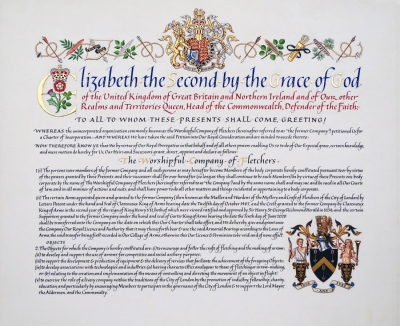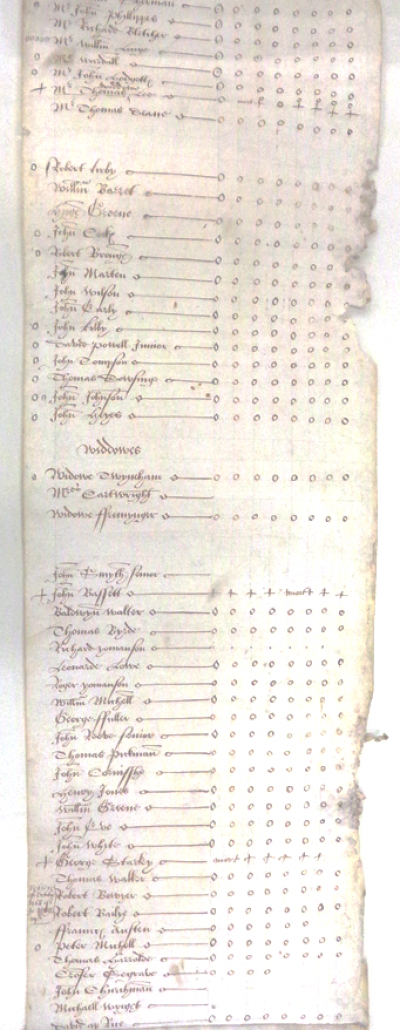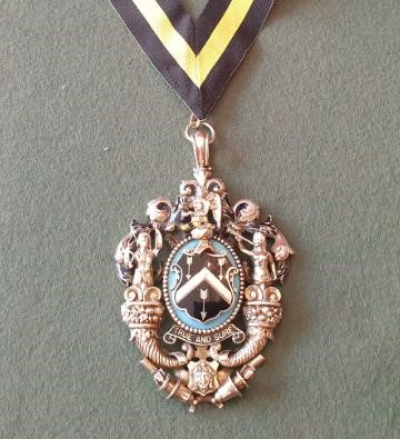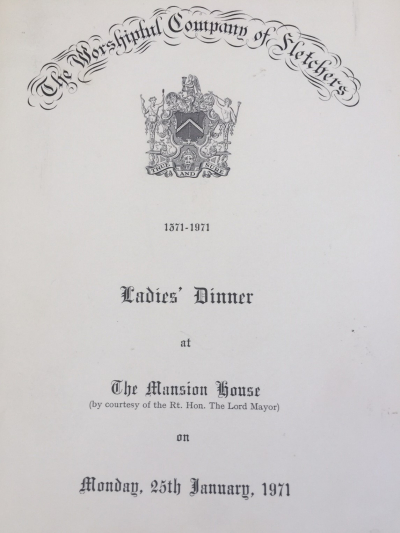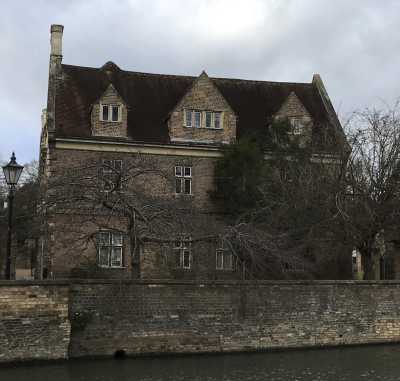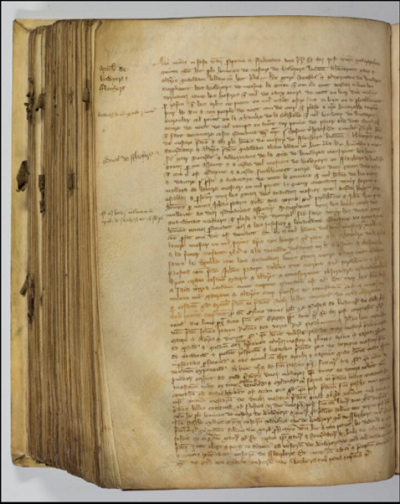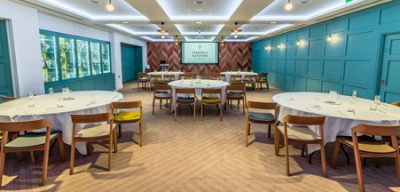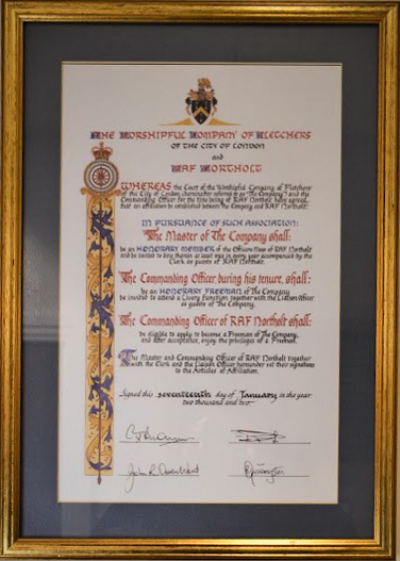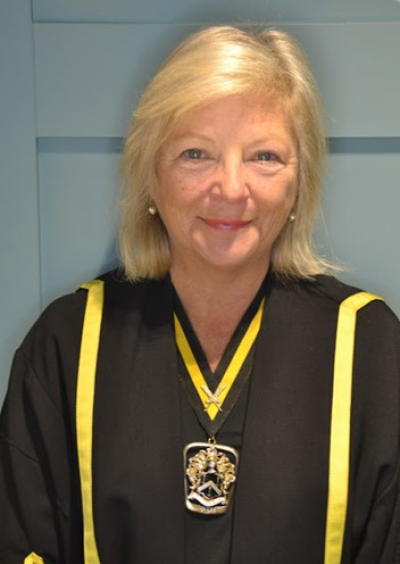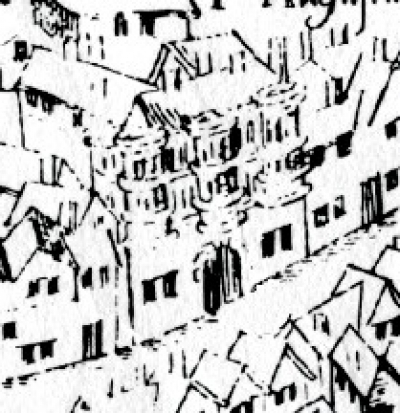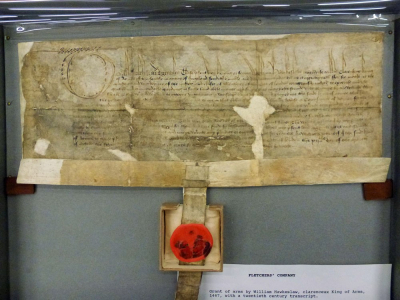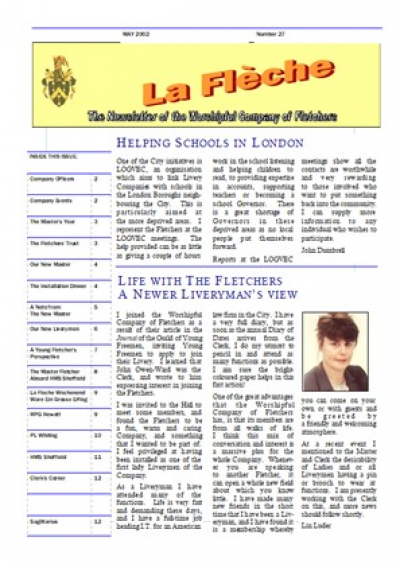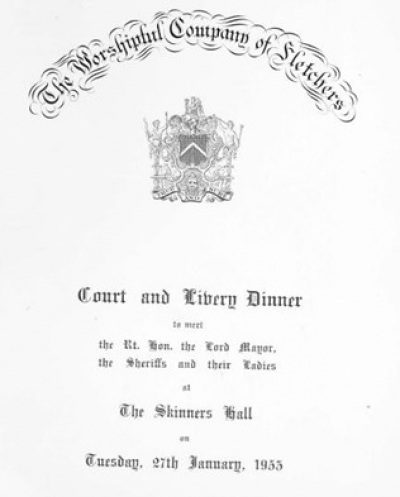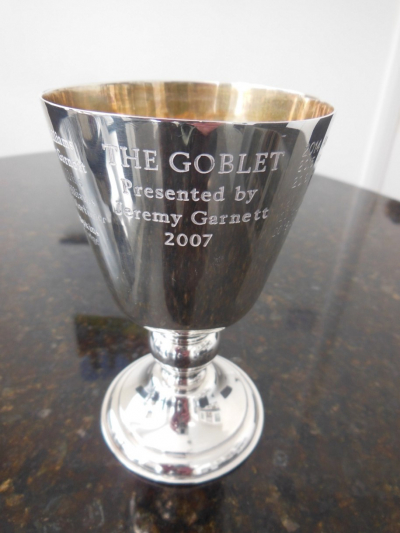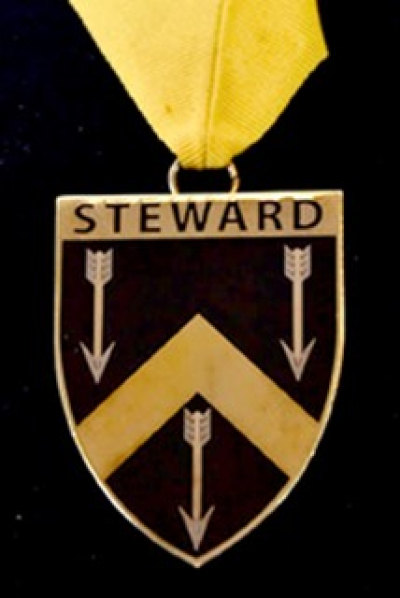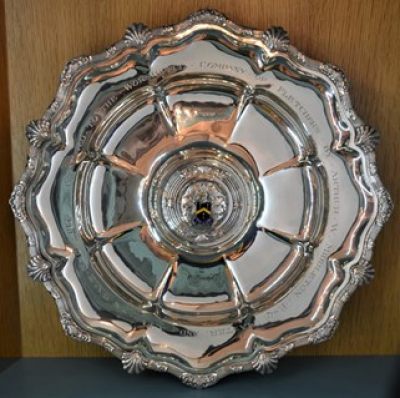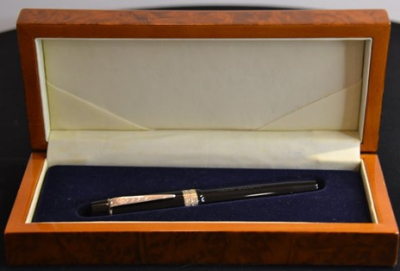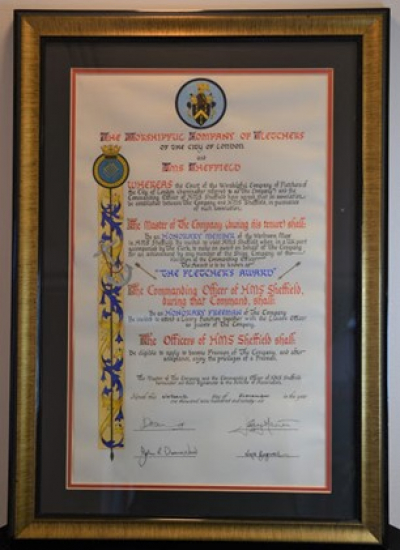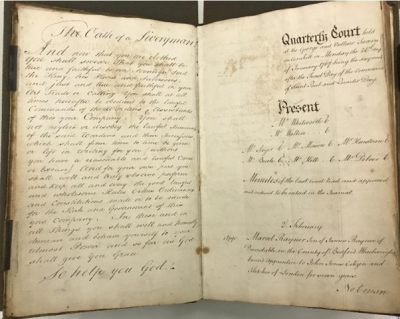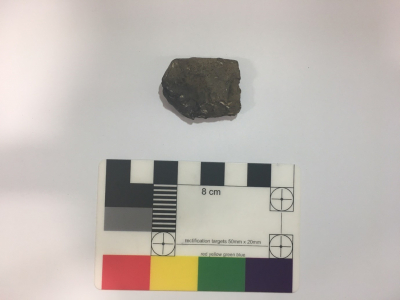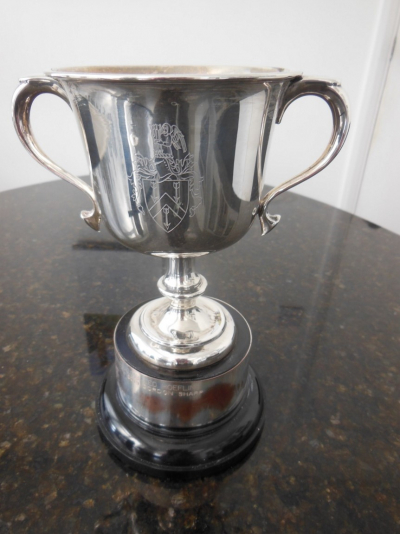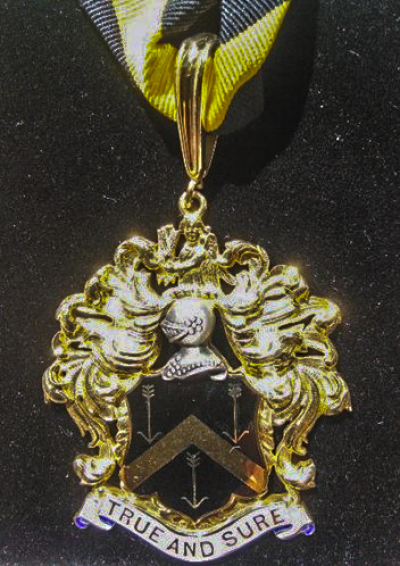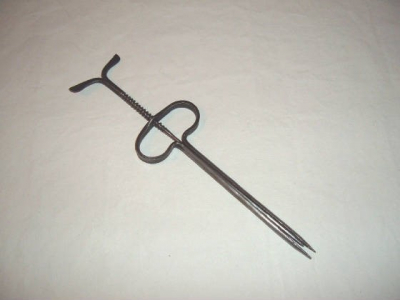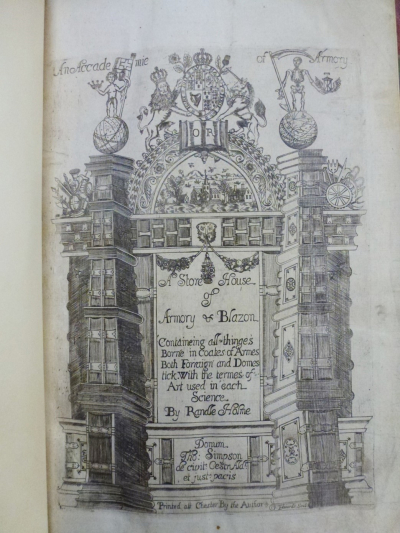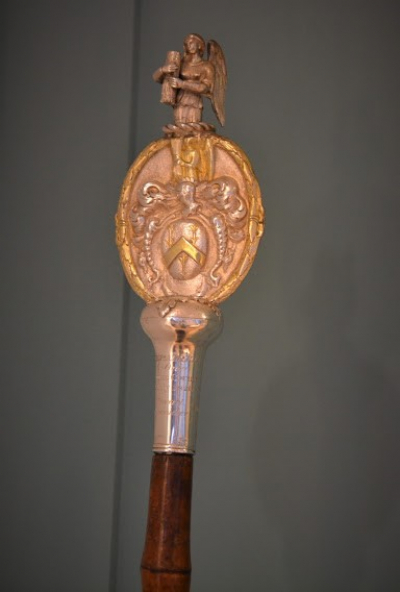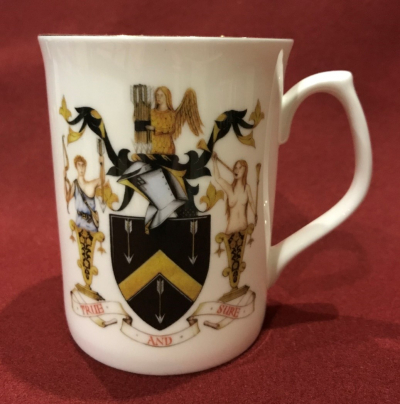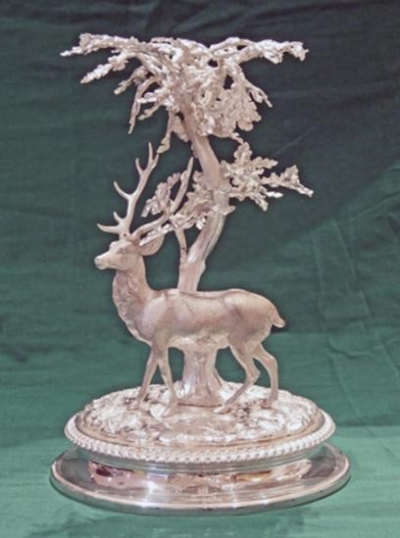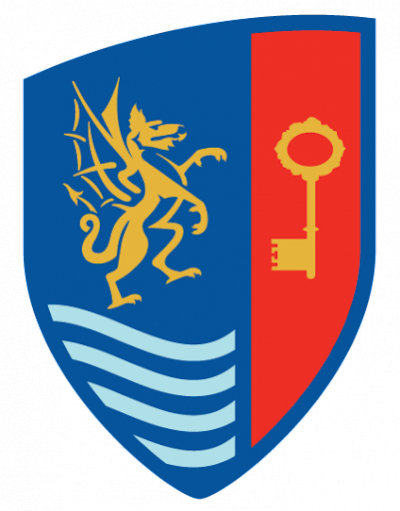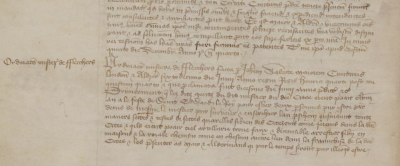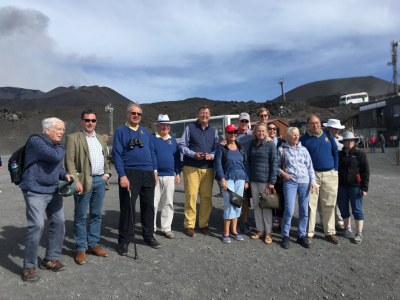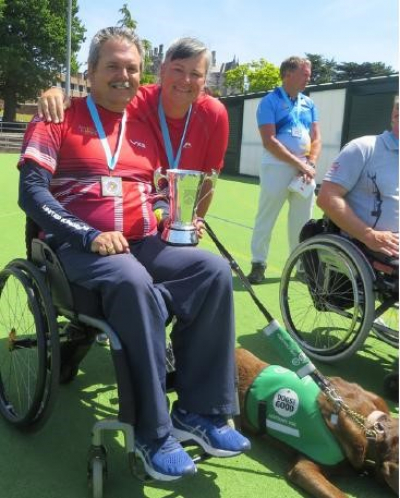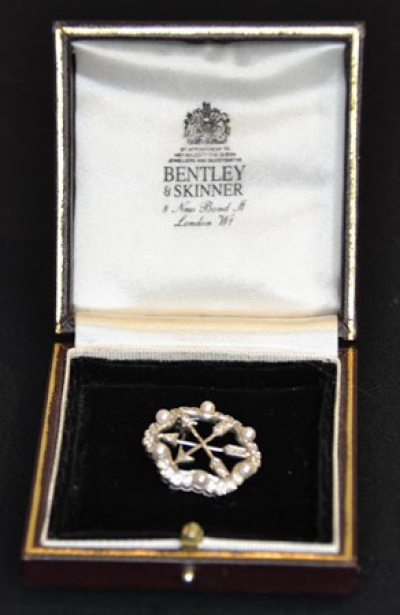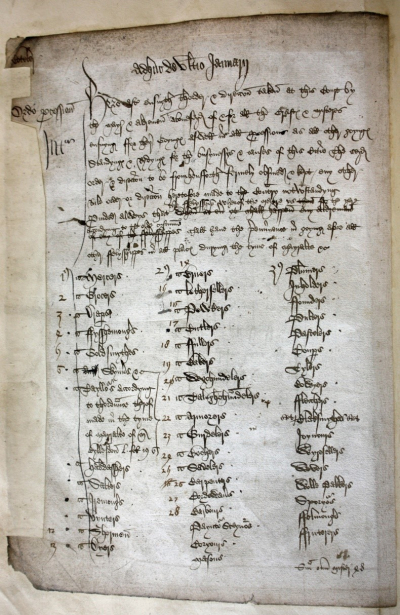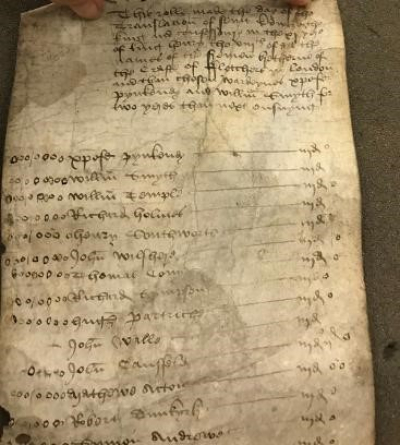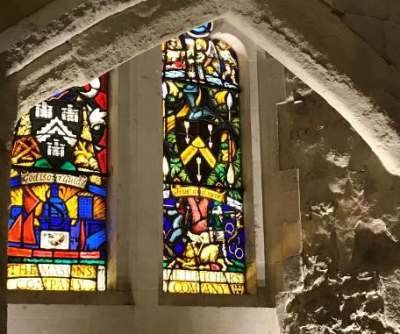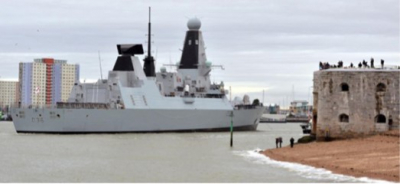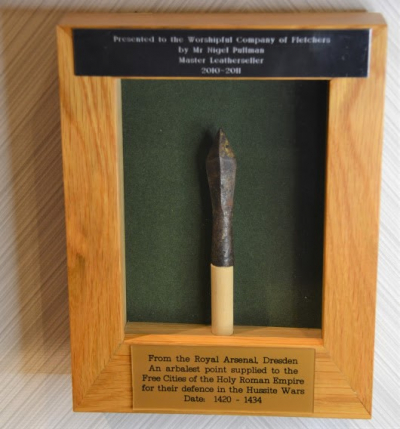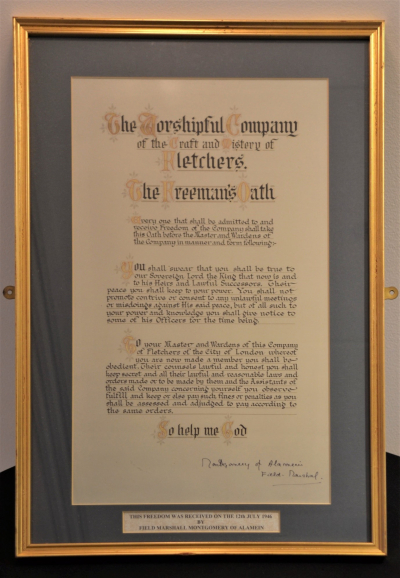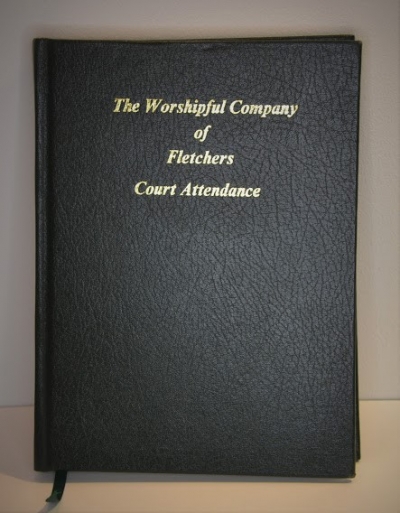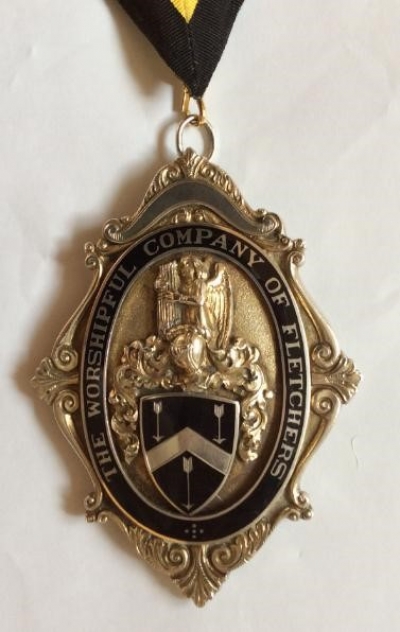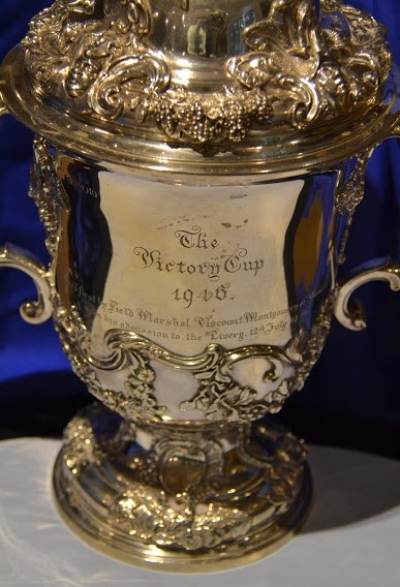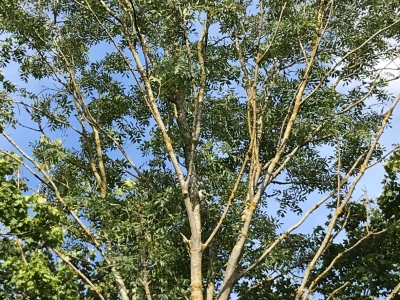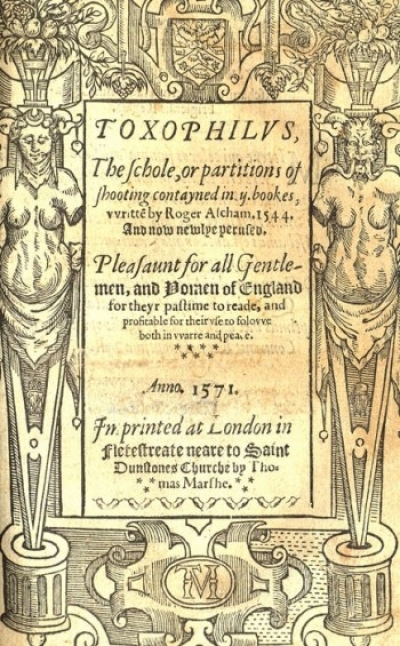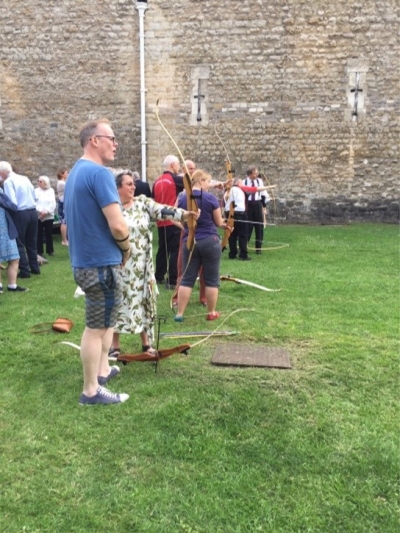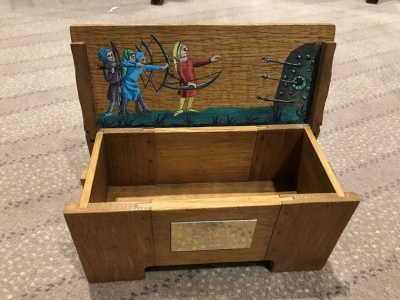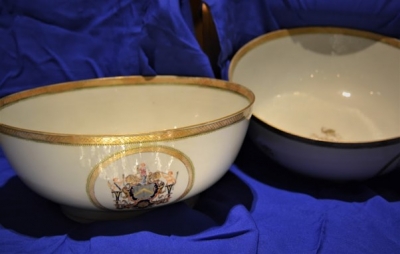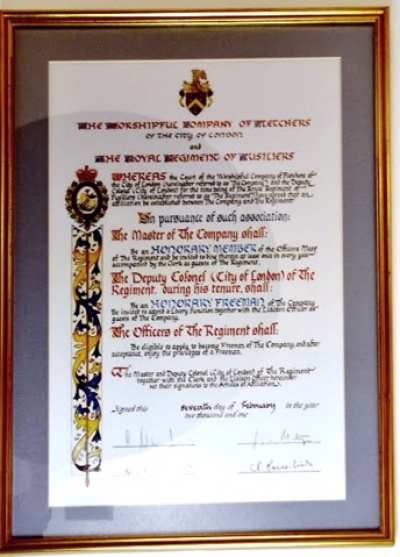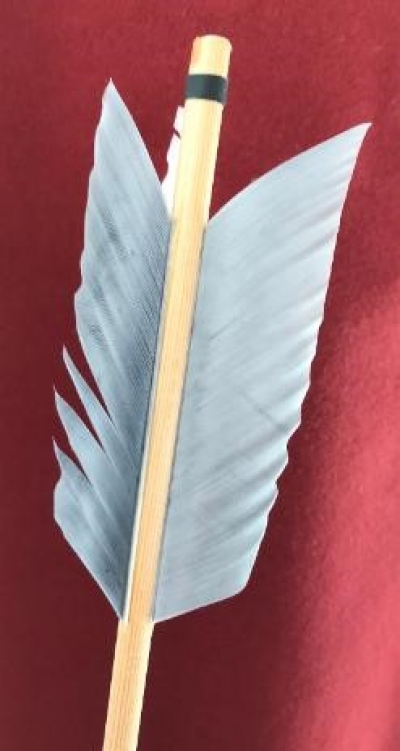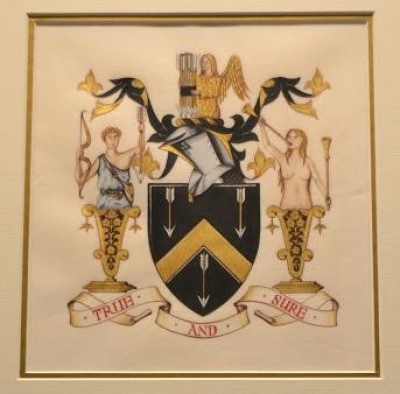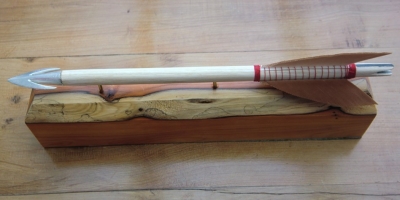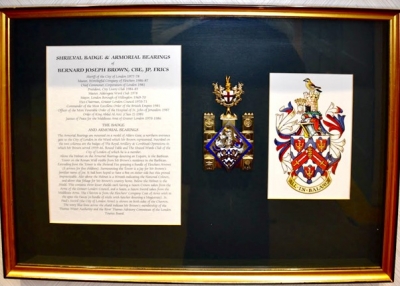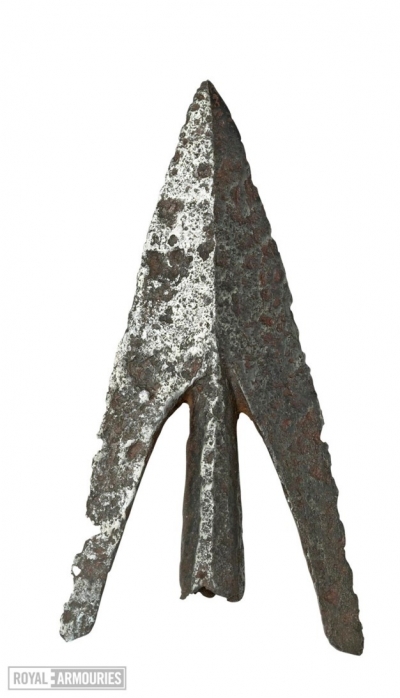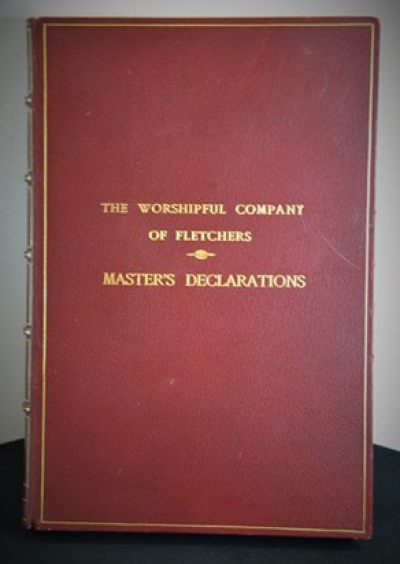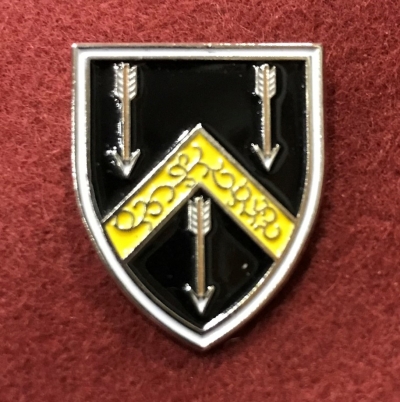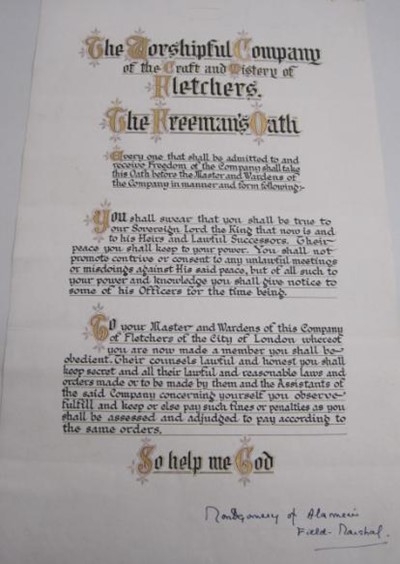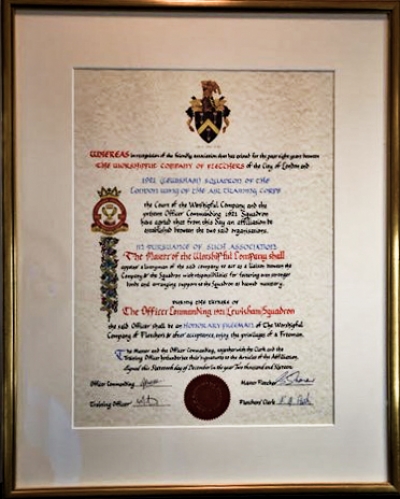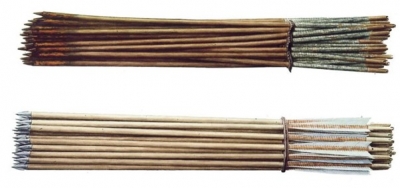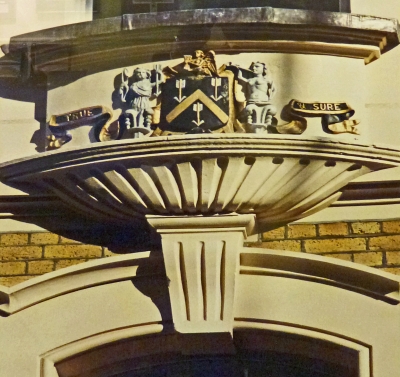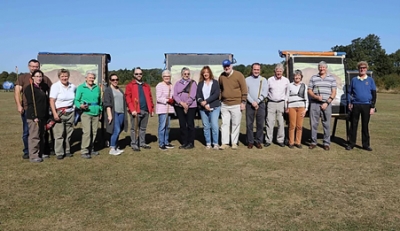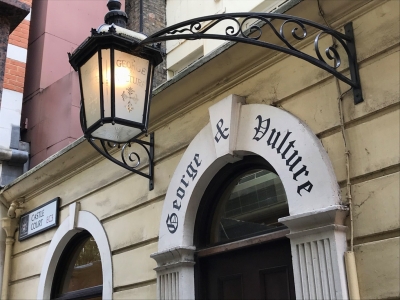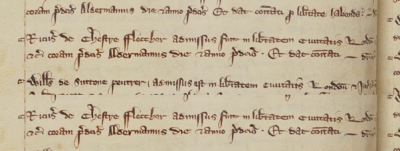65Objects
We are delighted to bring you a history of the Worshipful Company of Fletchers in 65 objects. (It's actually our 650th anniversary but that would have been a very large number of objects!) Each object reflects special moments in our history, from the fourteenth century to the present. We hope too that it gives you a flavour of the diverse and fascinating activities of Company and also of The Fletchers Trust. Join with us in celebrating our significant anniversary.
Our thanks to Liveryman Josie Gowler for coordinating and preparing these 65Objects with the assistance of our learned Clerk, Kate Pink.
After 650 years of not being a Chartered Company, the Worshipful Company of Fletchers petitioned for the grant of a Royal Charter in 2020. The Royal Charter is granted by the Her Majesty the Queen and is an instrument of incorporation which confers independent legal personality on the Fletchers and defines its objectives, constitution and…
It was not uncommon in medieval London for women to play an active part in their husbands’ businesses during the former’s lives, and also to continue these enterprises after their deaths, but the practice seems to have been particularly common among the Fletchers. The Worshipful Company of Fletchers’ early quarterage registers regularly show widows assuming…
The Worshipful Company of Fletchers is led by the Master aided by a Court of Assistants and the Clerk. The Master is elected for a year and presides at all Fletchers’ functions. Before the Master’s time in office, he/she plans several additional activities and trips for the year in addition to the usual calendar of…
To celebrate their 600th Anniversary, the Fletchers held a dinner at the Mansion House on 25th January 1971 – the dinnercard is shown above. The event was hosted by the Master C J Maples. A five-course dinner was served along with Moselle, Bordeaux, port and brandy.
Archery began at Finsbury Fields in North London in around 1498 and was later strongly encouraged by Henry VIII. Ayme for Finsbury Archers was first published in 1590 and describes the marks and longbow targets at Finsbury Fields, set up for longbow shooting at distances of at least 180 yards. It was reprinted in 1594…
The earliest livery companies were formed in the early Middle Ages as trade guilds. They were both employers' federations and trades unions, and their functions included ensuring high standards of business conduct and product quality from all their members, helping in the education of future generations in the particular ways of the trade or craft,…
It is a proud boast of the Fletchers’ and Farmers’ Companies that their new Hall was the first Livery Hall not actually constructed on the site of a previous Hall to be built in the City of London for 250 years. The Hall’s foundation stone was laid by the then Lord Mayor Sir Alan Davies…
These placemats were in use at Farmers’ and Fletchers’ Hall prior to the Hall’s refurbishment from 2013-15. Fletchers remember them in use 15 years ago and more. They looked good on the oak tables that were in service at one stage but were used little after those tables were replaced as part of the refurbishment.
As well as affiliations with the British Army and the Navy, the Worshipful Company of Fletchers is delighted to be affiliated with the Royal Air Force. Rather than a single squadron, the Fletchers are affiliated with an RAF Station, Northolt. An operational aerodrome since March 1915, it has been a base for military operations for…
The Clerk ensures the smooth running of the Worshipful Company of Fletchers, including looking after the membership, attending and taking minutes at meetings and Court, looking after the finances, organising events and a hundred and one other useful tasks. The Clerk’s role may be considered to be similar to that of a Company Secretary in…
The Austin Friars was an Augustinian Friary in the City of London, probably founded in the 1260s. In the late 1400s, on the Feast of the Decollation of St John the Baptist (29 August) all the Worshipful Company of Fletchers met and attended Mass at the Austin Friars. The Company undertook to ‘find for evermore’…
The Worshipful Company of Fletchers received its Grant of Arms on 12 October 1467. This was made to the Fletchers’ Company by William Hawkeslowe, Clarenceux King of Arms (an officer of Arms at the College of Arms, London). This is the Fletchers’ oldest piece of property and gives them the right to bear the coat…
The Worshipful Company of Fletchers’ newsletter began in 1971 as an annual update; it was succeeded by the full-colour La Fleche in 2001, which is published three times per year. The picture above shows the front page of issue 2. La Fleche includes articles on Company events written by attendees, introductions to new Fletchers, updates…
Dinners have always been an important and highly enjoyable part of the Fletchers’ calendar. The dinnercard shown is for the 27 January 1953 dinner at Skinners’ Hall. Dinners seemed to follow every Court Meeting since at least the mid-eighteenth century, and the whole Livery were invited to the dinner on St Mary Magdalene’s Day. Towards…
The Fletchers have an annual knockout golf competition every year. Past Master Jeremy Garnett inaugurated the contest and gave the Goblet as a prize in 2007. The Goblet is presented by the Master to the winner at the end-of-season golf dinner held at Fletchers and Farmers Hall. Previous winners are as follows: 2007 Mike Williams…
Stewards assist with the Fletchers’ formal events during the year, for example welcoming and ticking off arrivals to events, and handing out seating plans. The Chief Steward organises the rota and ensures an even spacing of events among the Stewards. There are twenty Stewards, including the Chief Steward, with three Reserve Stewards. Past Masters John…
The Rose Bowl was donated by Arthur Middleton Esq. Master of the Worshipful Company of Fletchers (1938-39). The custom of the Rose Bowl has been practised since at least Tudor times when the silver bowls demonstrated the host’s wealth, and the scented water they contained was used to rinse guests’ hands before, during and after…
The Poulter pen is used to sign the Court attendance book at each meeting of the Court and some Masters also use it to sign their declaration when installed as Masters. Captain A M (Tony) Poulter OBE donated this pen to the Company. Captain Poulter was Master in 2009/10. He served in the Royal Navy…
The Worshipful Company of Fletchers’ formal affiliation with the Royal Navy dates back over 30 years. Its first affiliation was with the Type 42 Destroyer HMS Sheffield which sadly was sunk during the Falklands conflict. After a brief affiliation with HMS Arrow from 1993, another HMS Sheffield then became the Fletchers’ ship until 2003 when…
The Worshipful Company of Fletchers’ minute books begin in 1767. Minutes of Court were hand-written in the minute book from 1767 to 1952. Thereafter the minutes were typed out on sheets of paper and stuck into the minute book. From 1996 they were word processed. The picture above shows the minutes for the Court meeting…
In addition to winding thread around the arrow shaft to secure the feather fletchings, glue was sometimes also used, with verdigris occasionally added to help stop infestation of the feathers by mites. The lump of birch bark tar in the picture was discovered in an early Medieval cemetery at Hatherdene Close, Cherry Hinton, Cambridge, and…
The annual Fletchers’ golf day has been held every summer since 1979. The MacLellan Cup is awarded to the player with the best Stableford score, which works as follows. Players receive the same number of strokes (free shots) as their handicap. Their net score (after deducting the strokes) is then compared with par for each…
Past Masters are issued with a badge of office after they have served their year as Master. The immediate Past Master is known as the Deputy Master, and can stand in for the Master at Court if the Master is unavailable. Past Masters remain on Court for a period of six years so that they…
A reminder of the damage inflicted by arrows in battle – and the ingenuity of battlefield surgeons throughout history – is demonstrated by the image above. Henry Prince of Wales, also known as Prince Hal, was struck in the face by an arrow at the Battle of Shrewsbury on 21 July 1403, at the age…
Although there were a number of tools associated with arrow making, many of which are described in a 17th century book The Academy of Armory, by Randle Holme III of Chester (pictured), there are no worthwhile illustrations. However, the book mentions the following tools for making arrows: (1) A 'Flote’ (float) – also used by…
This indenture dates to 1758 and relates to the apprenticeship of Uriah Streater as a Fletcher. The indenture set out what Uriah was and was not allowed to do during the apprenticeship, for example he was not allowed to marry, play dice or frequent taverns, and he had to serve his master faithfully. Reproduced by…
The Beadle, sometimes perceived as a Master of Ceremonies ensures the smooth running of events, as well as playing a part at Freedom admission and Livery clothing ceremonies. A good Beadle is much valued by the Clerk and Master. The Beadle carries a staff at ceremonial functions of the Worshipful Company of Fletchers, preceding the…
A limited edition of 600 mugs was produced to commemorate the 600th anniversary of the battle of Agincourt in 2015. The mug displays the Coat of Arms of the Worshipful Company of Fletchers, the Agincourt Coat of Arms, and the Agincourt 600 commemorative badge. The sale of the mugs raised money for the Fletchers’ Charitable…
The Stapleton Silver comprises seven beautiful Victorian Silver ornamental centrepieces, originally designed to hold fruit or flowers. The two main pieces are of two stags with oak trees; six smaller side pieces also have oak trees and stags standing erect, browsing or simply lying down. Collectively they are known as ‘The Stapleton Silver’ and are…
The Worshipful Company of Fletchers are delighted to be associated with four City Academies: the City of London Academy Islington, the City Academy Hackney (whose crest is shown above), the City of London Academy Southwark and the City of London Freemen’s School. The longest link, dating back at least to 1978 is with the City…
The Worshipful Company of Fletchers issued its first Ordnances on 16th June 1403, an extract from which is shown above. The Ordinances were issued by John Walcote, Mayor, and the Aldermen of the City. The Ordinances laid down that, every year on the Feast of the Translation of St Edward the King (13th October), the…
The annual holiday is an immensely enjoyable fixture of the Worshipful Company of Fletchers’ calendar of events. Jeremy Garnett, Master in 1995/96, was the first to arrange an overseas weekend trip, to the 14th and 15th century battlefields of France. This has been followed by trips to places including Bruges, Paris, Guernsey and Andalucia, ranging…
The Fletchers’ Disability Cup is the prize awarded to the winner of the Fletchers’ Disability Championship, an annual competition held at Lilleshall, home to Archery GB, British archery’s national governing body. Initiated by and partly sponsored by the Fletchers’ Trust, the scores gained at the event count towards the selection process for international competitions such…
The brooch above is worn by the Master’s Consort during their time in office. The badge was donated by Sir David Wootton at the end of his year as Master. Sir David was Master Fletcher in 2005/06 and was elected as the 648th Lord Mayor of London in 2011. Further information about Sir David Wootton…
The document above dates from 31st January 1515/16 and shows the order of precedence of the livery companies of the City of London. This sets out the order in which the companies walked or rode in City processions. The Fletchers’ Company is 39th in the order of precedence, coming after the Bowyers’ Company at 38…
This document is among the earliest surviving document in the Fletchers’ archives in the Guildhall Library, London, and is the quarterage list for 1519-21. It is essentially a list of names and records of attendance (see the circles to the left in the image above). Liverymen and freeman alike were obliged to attend each of…
This stained glass window can be found in the Guildhall’s west crypt, which was restored in 1973. The Worshipful Company of Fletchers successfully balloted to donate a window. The commission for the creation of the window was overseen by Past Master A P Hughes and placed with the stained-glass artist Brian Thomas. The design, as…
The Worshipful Company of Fletchers, as one of the five ‘warrior’ livery companies, has always been proud of its affiliations with the military: cadets, reserve and regular. HMS DEFENDER was the fifth type 45 (Daring Class) destroyer to enter service in the Royal Navy, and was commissioned at Her Majesty’s Naval Base Portsmouth on 21…
This arbalest point – donated by Mr Nigel Pullman, Master Leatherseller 2010-11 – is on display in Farmers’ and Fletchers’ Hall, the meeting place of the Worshipful Company of Fletchers. It was supplied to the Free Cities of the Holy Roman Empire for their defence in the Hussite Wars and dates from 1420 to 1434.…
On becoming a Fletcher, a solemn oath is sworn and this has not changed since the creation of the Worshipful Company of Fletchers in the 14th century. In brief, new Fletchers swear that they will be true to the Sovereign, keep the peace, obey the Company’s rules and pay their dues. The picture shows the…
This Court Attendance Book was in use in the 1960s to 1980s. Members of the Court of the Worshipful Company of Fletchers signed their names to verify that they were in attendance at the meetings. The Court has fourteen seats and comprises the Master, seven Assistants, who have yet to pass the Chair, and six…
The Master is assisted by an Upper Warden, whose badge is shown above, and a Renter Warden. After the Master has served his/her year of office, the Upper Warden becomes the Master and the Renter Warden becomes the Upper Warden. This arrangement gives the Renter Warden two years to get ready to become Master –…
The ceremony of the Loving Cup is an ancient and interesting feature of City Livery Company feasts. The cup is of silver or silver gilt and filled with spiced wine, called ‘sack’. The Fletchers own four loving cups for use in the ceremony; the oldest is engraved with an arrow and was presented to the…
Roger Ascham (1515 – 1568), writing about arrowmaking in his book Toxophilus: The Schole or Partitions of Shootinge, listed 15 types of wood that could be used to make arrows. “Birche, Hardbeame, some Oake, and some Ashe, being both strong enough to stande in a bow and light enough to fly farre are beste for…
Roger Ascham (1515 – 1568) was tutor to two of King Henry VIII’s children: the future King Edward VI and the future Queen Elizabeth I. As well as being an expert on classical languages, he also studied archery and wrote ‘Toxophilus: The Schole or Partitions of Shootinge’, which was published in 1544. This fascinating book…
The earliest-known reference to a Royal Fletcher in the Tower of London is 1329. King Henry V appointed the fletcher Nicholas Mynot to the role of Keeper of the King’s Arrows in the Tower in 1414; he was paid 6d per day, a large wage at the time, especially as he received a new livery…
Also known as the Governor’s Trophy, the Boleyn box holds the results of the annual Joint Archery Shoot of the Fletchers and Bowyers and is given as the prize. It is a model of the arrow box which was used as a coffin for Anne Boleyn. Inside it is a painting based on the Luttrell…
These two punch bowls are painted with the arms of the Fletchers’ Company. Armorial porcelain became fashionable during the eighteenth century and it was quite common for those with a coat of arms, both individuals and corporations, to order items to be made for them. The Chinese factories maintained agents in London who showed customers…
The Fletchers have a long association with the Royal Regiment of Fusiliers, whose Regimental Headquarters at the Tower of London recognises a link with the Tower stretching back over 400 years. The affiliation was confirmed on 7 February 2001 with an exchange of gifts, and the picture above shows the formal affiliation document. During his…
The South African medal was awarded to the Worshipful Company of Fletchers on 30 August 1901 in recognition of its assistance in raising and equipping the City of London Imperial Volunteers during the South African War (1899-1902). Despite being the smallest and poorest of all the City Livery Companies at the time, the Fletchers managed…
Until modern times, arrows were fletched with feathers. Due to preparations for the ongoing conflict with France, feather-collecting orders were made twice in the 1400s, in early 1417 and July 1426, along with the need to obtain wax, silk and timber for arrow production. Roger Ascham had a great deal to say about feathers in…
The Worshipful Company of Fletchers’ coat of arms is ‘sable, a chevron gold, thee broad arrows of the same, garnished silver’. The crest shows an ‘angel proper’ on a wreath of gold and sable. She holds in both hands a bundle of arrows. The Fletchers’ motto – adopted on 25 November 1872 – is ‘True…
Prize arrows made by Honorary Liveryman, Lindsay Head and her husband and Liverymen of the Bowyers’ Company, Richard, are put on display at Fletchers’ dinners, and are also given to various worthy recipients. The arrow in the picture – which measures nine inches overall – is made from poplar, a wood commonly used for arrows…
Bernard Joseph “Joe” Brown CBE, JP, FRICS had a long and distinguished career of public service, including his role as High Sheriff of the City of London 1977-78. He was Master of the Worshipful Company of Fletchers in 1986-87. He was awarded the CBE in the 1982 New Years’ Honours. Mr Brown’s shrieval badge and…
Roger Ascham, 1500s archery expert and author of ‘Toxophilus: The Schole or Partitions of Shootinge’, had the following opinion on arrowheads: ‘Our English heads be better in war than either forked heads or broad arrowheads. For first, the end being lighter, they fly a great deal the faster, and, by the same reason, giveth a…
The proposal that incoming Masters of the Worshipful Company of Fletchers should sign a declaration was made in 1938. Masters only began doing this from 1945, after a book was presented by Mr Vining on 11 May 1943. The declaration states that the Master will execute the office justly, faithfully, and diligently. The first such…
Fletchers often wear a lapel pin in the shape of the Fletchers’ shield to show that they are members of the livery, or they give them to their partners as a gift. Some of the Fletchers have even made them into cuff links to wear at events, as well.
At a meeting on 29 November 1945, the Court discussed the question of admitting distinguished persons to the Freedom and Livery of the Company by Gift. The Court unanimously decided to offer Field Marshal Bernard Law Montgomery (1st Viscount Montgomery of Alamein, KG, GCB, DSO, PC, DL) the Freedom and Livery of the Worshipful Company…
The Fletchers have been closely associated with 1921 (Lewisham) Squadron of the Air Training Corps since early 2008. Liverymen regularly attend many of the squadron’s events and, since 2014, the Master Fletcher has made an award of a silver prize arrow to the cadet who has best displayed the virtues of the Fletchers’ motto “True…
Archers continued to be a vital part of the army in the 16th Century. Over 3,500 arrows were recovered from the wreck of the Mary Rose, Henry VIII’s flagship which sunk in the Solent on 19 July 1545. The top image shows the arrows recovered from the wreck – although both the arrow heads and…
The Worshipful Company of Fletchers rented a Hall in St Mary Axe from Holy Trinity Priory from at least the beginning of the sixteenth century. Following the Priory’s dissolution in 1531, the Company appears to have purchased the freehold of the Hall from the Crown’s successor in title Sir William Pykerynge sometime prior to 1547/47.…
The Fletchers have been meeting for archery days at Noak Hill in Essex twice a year since 2008. After few practice rounds, a fun competition is held. This starts with target shooting followed by field archery in the afternoon, pitting the archers against strategically placed animal targets which makes for a very interesting afternoon in…
From 1767 to 1808 the quarterly Court meetings of the Worshipful Company of Fletchers were held at the George and Vulture Tavern, tucked away in Castle Court just off Cornhill in the City of London. The Fletchers’ own Hall at St. Mary Axe in the City was let out from 1747, eventually being sold in…
Those wanting to become a Liveryman of the Worshipful Company of Fletchers must first apply for and be admitted to the Freedom of the City of London. The Declaration of a Freeman is as follows: “I {names in full} do solemnly declare that I will be good and true to our Sovereign Lady Queen Elizabeth…
This charming image of English archers being taught to shoot at a target is at the foot of one of the pages of the Luttrell Psalter and dates to 1320-1330. An order issued by King Edward III in 1363 required every man between 15 and 60 years old, on feast-days and in leisure time, to…

